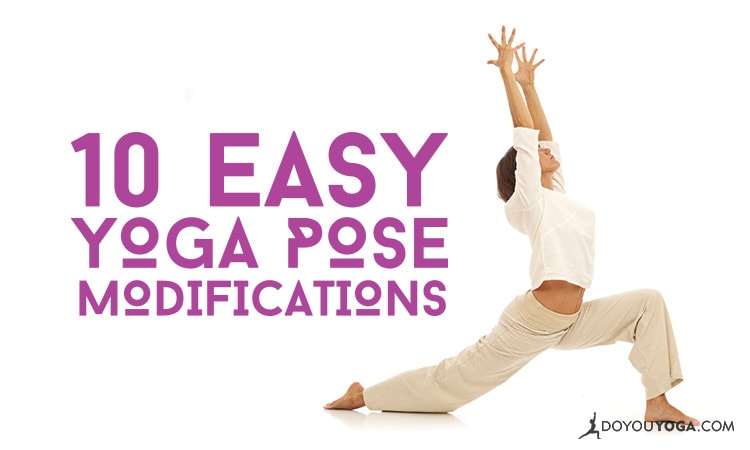Sometimes we show up to class and we’re just plain tired. Other times, we want the stretch, but we’re injured. Should we just stay home? Maybe, as in the ‘extreme’ case of being sick, but in many cases, there are ways to modify your yoga practice so that you’ll still reap the rewards of deep breathing and investing time in yourself.
Of course, if you have a specific ailment or condition that needs to be considered, it’s helpful to work with a yoga teacher one-on-one, so you can create a custom sequence that takes your needs into account. Also, it’s best to check with your doctor before starting or continuing a yoga practice.
Having said that, here are my suggestions for 10 easy modifications you can try in your yoga practice, as you need them.
1. Bend your knees in Downward-Facing Dog and any forward fold.
Let’s say you’ve been running a lot and your hamstrings are really tight. While you know the stretch that Downward Dog would provide would be great, it hurts when you actually do it. If that’s the case, keep your knees bent while in the pose.
This doesn’t mean bend them first and then straighten them; it means to keep them slightly bent the whole time. This will relieve some of the stretch on the hamstrings and calves. Apply the same action to forward folds from standing or seated.
2. Drop your knee down in Lunges.
When coming into a Runner’s or Crescent Lunge, drop the knee of the back leg. You’ll still get the hip flexor (Psoas muscle) stretch without all the effort. On a related note, drop your knee in Side Plank to decrease pressure on the supporting arm. This also works if you can’t put full support on your wrists.
3. Use blocks under your hands in Downward-Facing Dog.
Sometimes people with wrist tenderness find that using a block (low foam block or high cork block) can decrease the discomfort. This can vary depending on the person, so if this is something you experience, try it and see if it helps.
4. Skip Low Push Up or Chaturanga Dandasana (in Sun Salutations) and move directly to Downward-Dog from Plank.
Just as using blocks can help decrease wrist tenderness, so can eliminating Low Push Up from your practice. When moving through Sun Salutations and coming into High Push Up, move directly to Downward Dog. This also works well if you have a shoulder injury.
5. Skip Upward Dog and replace with Low Cobra instead.
From an overall effort perspective, Upward Dog is a bit more effortful than Low Cobra. It can act as an accessible backbend for someone with sore wrists, a de-conditioned upper body or lower back tenderness.
6. Skip moving to the ground in Sun Salutations and stay on the feet for Warrior I Pose.
I’ve worked with some students that get dizzy when moving up and down in Sun Salutations. For students with this symptom, staying upright is better.
Stay on your feet and hold Warrior I a bit longer as the class is moving through High to Low Push Up. If you’re practicing solo, skip moving to the ground and hold Warrior 1 on each side for 5 to 8 breaths.
7. Use a block for any twisting pose, like Twisting Crescent Lunge and Twisting Triangle.
Blocks create steadiness and with increased foundation, we can feel stronger and supported. Use a block on the inside of the foot of the front leg for any twisting pose, like the ones noted above.
8. Use a strap for any bind.
Tight shoulders and the constant rounding of the back can create inflexibility around the shoulders and weak upper back muscles.
To help strengthen the muscles that draw the shoulder blades together (Rhomboids), and stretch the external rotator muscles of the shoulder (Teres Minor and Infraspinatus), use a strap in any “hands-behind-the-back” bind.
9. Rest in Child’s Pose as much as you want.
How many times have you heard this in class and pushed yourself through the class anyway? When you’re coming back from injury or just starting out, or just generally tired, it’s healthy to balance the effort of the practice with rest in between.
As you build up your overall conditioning (and even while you’re doing that), you’ll find moments of rest in the practice. That forward fold in between poses, or as you come to floor and proceed with floor work, can be moments to catch your breath.
10. Practice 50 percent physical effort (or anything less than all out pushing yourself).
I was at a teacher training once and about three days into it, I had an all-out, full-on breakdown. I was exhausted on all levels and just felt like going home. I called home and my mother said, “Why don’t you practice with less than full out effort and see if you can get through at least the next day?” I had never thought of this.
I tried it…and it worked! I felt better as that next day progressed, and actually felt stronger by the end of the week. We often approach things with an “all or nothing” perspective, and think we’re missing out on the benefits of what we’re doing.
But we know that the benefits of yoga practice are plentiful, and many have little do with what poses we’re doing, the pace we’re keeping, if it’s heated or not, and other factors.
The “doing” aspect of yoga is about more than just the poses. Showing up, carving out time for ourselves, being in silence, taking deep breaths—these are all the benefits of the practice. They can be experienced by anyone, regardless of experience level, physical capabilities, and knowledge of the practice.
Sometimes, the most illuminating practices happen when we show up with no expectations other than to take care of ourselves. This is, of course, the magic of yoga.


